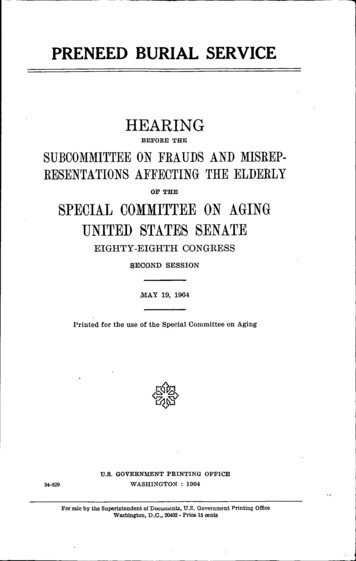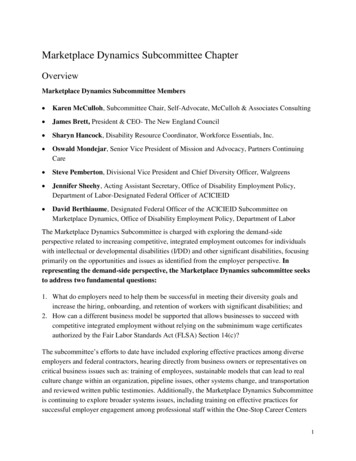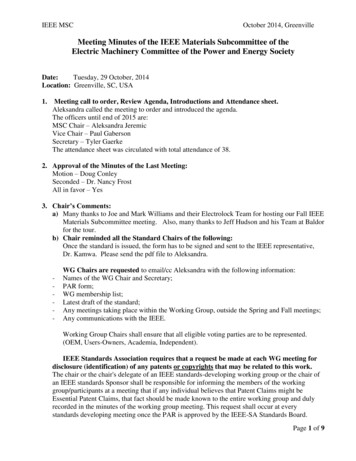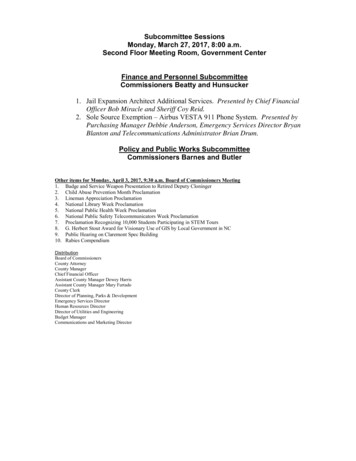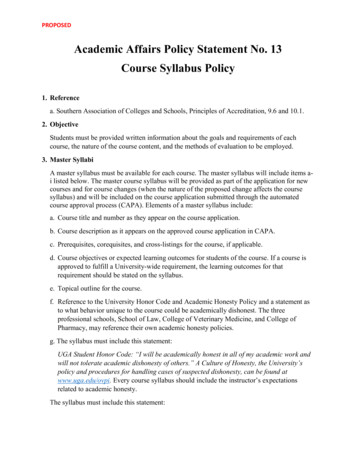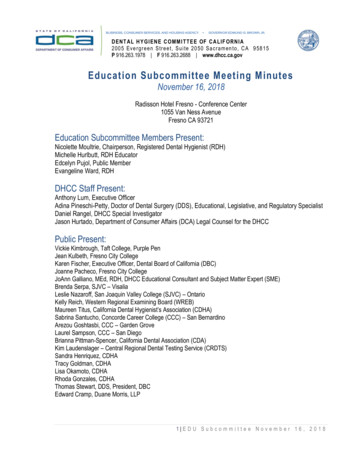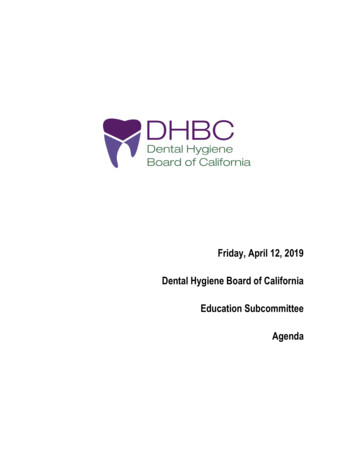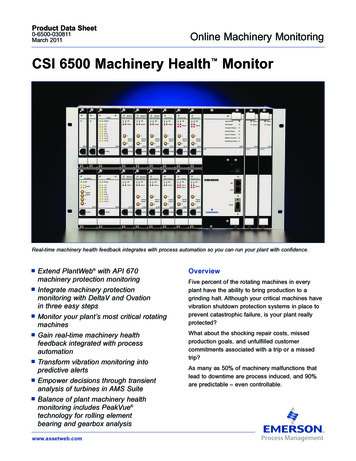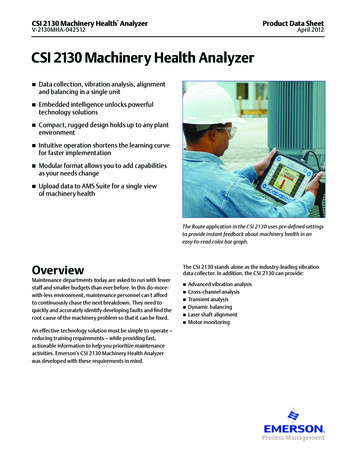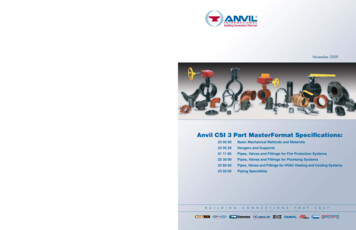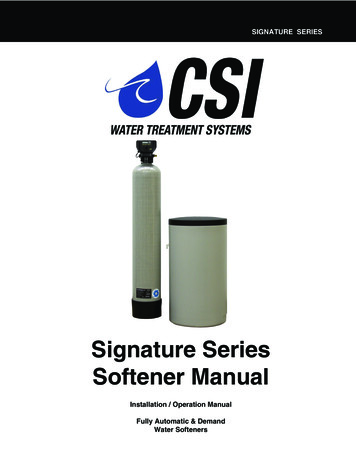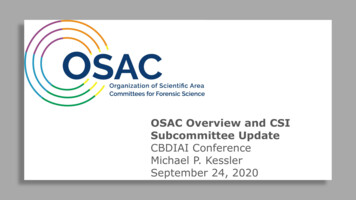
Transcription
OSAC Overview and CSISubcommittee UpdateCBDIAI ConferenceMichael P. KesslerSeptember 24, 2020
Forensic Science Landscape in U.S.U.S. population of 327M 50 States divided into 3007 counties: 409 Federal/State/Local Crime Labso 88% accredited (as of December 31, 2014)U.S. has NOforensic scienceowner! 18,000 Law Enforcement Agencies 2,400 Medical Examiner/Coroner Offices 2,300 Prosecutor Offices 3,000 Public Defenders Offices2**Data Sources: DOJ’s Bureau of Justice Statistics
Issues in Forensic Science Fragmented and inconsistent operations within andbetween jurisdictions Under resourced and understaffed labs Different types of practitioners with different levelsof training and performance standards Lack of mandatory training, continuing education,certification, and accreditation programs Limited opportunities for research funding Lack of standards within and between disciplines33
OSAC’s OriginNational Academy ofSciences (NAS)Report published:February 18, 2009NIST announcescreation of OSAC atNCFS: February 4, 2014DOJ and NIST sign MOU to strengthen thenation’s use of forensic science throughcreation of National Commission onForensic Science (NCFS) & GuidanceGroups (later called OSAC): February 20134NIST held first OSACSubcommittee Meetings:January 2015
20142013Scientific Working GroupTopic (Forensic Discipline)YearsSWGDAMDNASWGMATMaterials (Trace)23SWGFASTFriction Ridge (Fingerprints)20SWGDRUGControlled Substances18SWGITImaging Technologies18SWGDOCDocument Examination181998SWGDEDigital Evidence1998SWGGUNFirearms & Toolmarks171998SWGFEXFire Debris & Explosives17SWGSTAINBloodstain Pattern132004SWGTREADShoeprint & Tire Tread112004SWGDOGDog & Orthogonal Detector11SWGGSRGun Shot 009FISWGFacial Identification62010SWGDVIDisaster Victim Identification52010SWGMDIMedicolegal Death Investigation52011SWGGEOGeological Materials42011SWGWILDWildlife Forensics4SWGSPEAKERVoice Analysis31988TWGDAM27 SWGDAM1992TWGFIBE Collectively, these 21 SWGs have hadover 750 participants and produced over250 019891988Scientific Working Groups (SWGs)SWGMAT1995TWGFASTSWGFAST1997TWGDRUG SWGDRUG1997TWGIT SWGIT1997TWGDOC SWGDOC Most SWGs have ceased operations SWGDAM, SWGDE, SWGDRUG, & FISWGcontinue to operate200220072008At least three other SWGs existed previously:SWGIBRASWGMGFSWGCBRNIllicit Business RecordsMicrobial Genetics and ForensicsChemical, Biological, Radiological and Nuclear Terrorism5201217
HARMONIZATIONBALANCETo create a sustainable organizational infrastructurededicated to identifying and fostering thedevelopment of technically sound, consensus-baseddocumentary standards and guidelines forwidespread implementation throughout the forensicscience communityCONSENSUS6OPENNESS
OSAC StakeholdersTo support it’s mission, OSAC collaborates with and supports a wide-range of stakeholderswith varied interests: NISTThe U.S. Department of Justice (DOJ)OSAC members (present and future)Forensic science service providersAcademic institutionsRepresentatives of the criminal justice systemInternational and national standards developmentorganizations (SDOs)7 Professional organizations (forensic science &others) Federal, state & local government agencies Non-government organizations (NGOs) Private sector manufacturers & service vendorssupplying forensic service providers Quality system providers (accrediting & certifyingbodies) The public
OSAC’s Structure (OSAC 1.0) 546 members268 affiliates2578 applications48 states represented(as of June 1, 2020)8
9
OSAC Employer & Job rQA searcher
What OSAC DOESN’TDOESFacilitates developmentof science-basedstandards through theformal SDO processesPublish standardsHave the authority toenforce standardsEvaluates existingstandards published bySDOs for placement on theOSAC RegistryEndorses standardson the Registry &promotes theirimplementation11
OSAC Document Tiers1 Documents on theOSAC RegistryApproved by OSAC –highest level of vetting37documents2 3OSAC supportedstandards publishedby an SDO Completed SDOconsensus process OSAC draftedstandards sent to anSDODrafted with inputfrom RC and approvedby SAC13694documentsdocuments124 Under development Working draftdocument insideOSAC developmentprocess and not yetpublicly available158documents
OSAC Registry Trusted repository of high-quality, science-basedstandards and guidelines for the practice of forensicscience Documents developed using a consensus-basedprocess and pass a technical merit review by forensicscience practitioners, academic researchers,statisticians and measurement scientists Adoption by relevant agencies and science/osac-registry13
OSAC Registry Standards37standards 3 Biology/DNA1 Bloodstain Pattern Analysis3 Digital Evidence2 Disaster Victim Identification1 Dogs & Sensors3 Facial Identification2 Fire & Explosion Investigation7 Materials (Trace)2 Odontology2 Seized Drugs3 Toxicology2 Wildlife Forensics6 e/osac-registry-approved-standards14
OSAC Registry Implementation Pathways Self Implementation Professional Associations Legal Community Certification & Accreditation Bodies Funding Bodies State Forensic Science Commissions/Regulatory ementation-plan15
Implementation Resources Implementation Strategy Sessions Recap Report Frequently Asked Questions (FAQs) Lab Declaration Form Standards Implementation Tracker that lists allstandards by discipline and categorizes them intovarious development stages (Tier 1-4) Detailed “How To” Guidelines with step-by-stepinstructions for ommittees-forensic-science/implementation-plan16
Other OSAC searchneeds-assessments.cfm17
Other OSAC Initiatives (continued)18
OSAC Websitewww.nist.gov/osac19
OSAC Communications Provides monthly updates onforensic science standardsmoving through developmentprocess at SDOs and thosemoving through OSAC RegistryprocessAvailable on OSAC’s dards-bulletin Quarterly communication that providesupdates on OSAC’s program status,activities, accomplishments, andopportunities for public input with internaland external audiences.Available on OSAC’s letter20 Follow nce/
Crime Scene Investigation SubcommitteeTask Group OrganizationCSI SubcommitteeCrime Scene ReconstructionTask GroupCollision Reconstruction TaskGroupResponse & IdentificationTask GroupCollection & PreservationTask GroupDocumentation & ReportingTask GroupForensic Nursing TaskGroup**Forensic Nursing Task GroupbecomesForensic Nursing SubcommitteeOctober 1, 202021Veterinary Forensic SciencesTask GroupForensic Entomology TaskGroup
Research & Development Needs Assessing the Culture of Contextual Bias in Forensic Scene Evidence Collection,Handling, and Processing Assessment of Level of Personal Protective Equipment (PPE) Required at CrimeScenes Decontamination of Crime Scene Equipment Laboratory Techniques and Technologies at the Crime Scene Use of Technology for Crime Scene science/osac-research-development-needs22
FY2021 Priorities 1. Focus on completion of standards that relate to the base of practice includingeducation/training/professional development for specialties (i.e. CSR, CR, ACI, VFS,FE) crime scene investigation and reconstruction fundamental principles (e.g., initialresponse and identification, collection and preservation, documentation andreporting, specialized scene fundamentals, and QMS/QA-QC). 2. Following base of practice standards development, move into specific methods. 3. Continued collaboration with overlapping SCs or SCs with shared interest instandards under development as well as support to SDOs (ASTM & ASB).23
Draft Standards in Development (Tier 4) Standard Guide for Crime Scene Reconstruction Crime Scene Reconstructionist Training, Continuing Education, and ProfessionalDevelopment Standard for Initial Response at Scenes by Crime Scene Investigators Standards for the Clinical Veterinary Forensic Examination of the Suspected AbusedAnimal Standard Practice for the Documentation and Processing of Animal Abuse Scenes Standard Practice for Crime Scene Metrology Standard Guide for Quality Management in Crime Scene Investigation andReconstruction Standard Practice for the Collection and Preservation of Biological Materials Standard Method for the Chemical Testing of Suspected Projectile Impacts Standard Method for Measuring Trajectory Angles Standard for the Collection and Preservation of Arthropod Samples from Humansor Other Animals24
New Standards Sent to SDO (Tier 3) ASTM International Committee E30 on Forensic Sciences Standard Practice for Crime Scene Investigator Training, Continuing Education,Professional Development, Certification, and Accreditation Standard Guide for Sexual Violence Investigation, Examination, and Evidence Standard Practice for Transmittal of Evidence in Sexual Violence Investigation Standard Practice for Specification for Equipment and Supplies in SexualAssault Investigations AAFS Academy Standards Board (ASB) Crime Scene Investigation Consensus Body Guiding Principles for Crime Scene Investigation and Reconstruction Standard for Initial Response at Scenes by Law Enforcement Standard for On-Scene Collection and Preservation of Physical Evidence Standard Practice for the Documentation and Processing of Shooting Scenes25
Highlights from OSAC Proposed StandardGuiding Principles for Crime Scene Investigation and Reconstruction Provides guiding principles and recommendations for practicing crime sceneinvestigators and reconstructionists. Each crime scene is unique and requires crime scene investigators andreconstructionists to continuously evaluate how to proceed with processing in amanner that is safe and best preserves the evidence and its context. All decisionsmade by a crime scene investigator or reconstructionist before, during, and after acrime scene is processed should consider the following:1. Legal Considerations2. Personnel Safety3. Scientific Reliability4. Preserving Context5. Maintaining Evidence Integrity6. Transparency and Ethics7. Managing Bias26
Highlights from OSAC Proposed StandardStandard for Initial Response at Scenes by Law Enforcement Applies to the first law enforcement personnel who respond to a scene and whoseinitial or primary responsibility does not involve crime scene investigation. Addresses: Arrival Procedure Safety Considerations Medical Intervention Assessing the Scene Scene Containment and Control Evidence Preservation Turing Scene Over to Investigators Document Actions and Observations27
Standards Published by SDO (Tier 2) ASTM International Committee E30 on Forensic Sciences ASTM E620-11(18) Standard Practice for Reporting Opinions of Scientific orTechnical Experts ASTM E860-07(13)e3 Standard Practice for Examining and Preparing Items thatmay Become Involved in Criminal or Civil Litigation ASTM E1020-13e1 Standard Practice for Reporting Incidents that may InvolveCriminal or Civil Litigation ASTM E1188-11(17) Standard Practice for Collection and Preservation ofInformation and Physical Items by a Technical Investigator ASTM E1459-13(18) Standard Guide for Physical Evidence Labeling and RelatedDocumentation28
Standards on the OSAC Registry (Tier 1) ISO 21043-2 Forensic Sciences - Part 2: Recognition, recording, collecting transportand storage of items (effective December 3, 2019). ASTM E2917-19a Standard Practice for Forensic Science Practitioner Training,Continuing Education, and Professional Development Programs (effectiveNovember 5, 2019).29
ASTM E291719a30
Registry Approved (December 3, 2019)ISO 21043-2 Forensic Sciences - Part 2: Recognition, recording, collectingtransport and storage of items SCOPE- This document specifies requirements for the forensic process focusing onrecognition, recording, collection, transport and storage of items of potentialforensic value. It includes requirements for the assessment and examination ofscenes but is also applicable to activities that occur within the facility. Thisdocument also includes quality requirements.31
Accessing Published StandardsASB – public access (currently)ASTM – free access via OSACLicense (currently through OCT2021)32
How Can You Get Involved?Sign up for OSACcommunicationsBecome an OSAC T/subscriber/newStay informedReview and commenton documentshttps://www.nist.gov/osac33
THANK YOU!Michael P. Kesslermkessler@fiu.edu
Oct 02, 2020 · Standards Implementation Tracker that lists all standards by discipline and categorizes them into . Task Group Organization CSI Subcommittee Crime Scene Reconstruction Task Group Collision Reconstruction Task . (i.e. CSR, CR, ACI, VFS, FE) crime scene investigation and reconstructi
